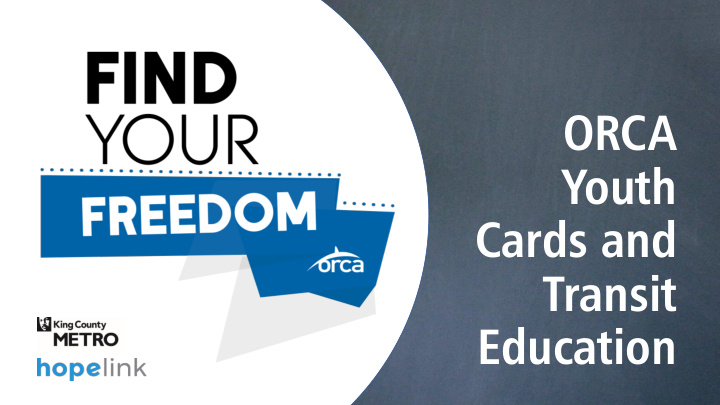



ORCA Youth Cards and Transit Education
Provide $10 ORCA Youth • State funded Cards • Joint effort with the Regional Partners • Coordinated marketing campaign To King County Teens
Goals • Increase long-term ORCA usage in teens by lowering barriers to obtaining a card • Provide mobility education and resources to students • To center equity in planning and outreach
Why High School Youth?
Teens Need Options Teens need flexible, affordable • transportation Teens frequently asked for cards for their • siblings and friends Teens need help with costs • Teens need context • As potential riders, teens need more • information about how transit improves their access to the community
Opportunities Teens will enter the work force soon • Teens need to get around on a • budget Increased mobility opens up • educational and financial opportunities Mobility is key to breaking poverty • cycles, building strong communities, and promoting civic engagement
ORCA Youth is Difficult to Obtain The mailing form is complicated • ORCA To-Go usually operates during • school hours The Customer Service Office operates • during school hours Paying full bus fare getting to and from • an event or the Customer Service Office
Schools Lack Transit Knowledge • School staffs have limited knowledge of transit options • McKinney-Vento Liaisons face restrictions and insufficient information • Schools encourage or require after- school activities, like community service, but cannot recommend robust options for transportation
Highlights
Participating School Districts • 11 School Districts • 35 participating high schools • Plus 11 school-related departments/organizations
Non-School Organizations • 40 organizations and departments received enrollment kits • 35 successfully distributed cards • 29 additional organizations and departments received marketing materials and/or information to share with their communities and networks
6,319 ORCA Youth Cards Distributed
Community Stories
“The thing is, the [volunteer] hours are required by school to graduate but there’s no help to get him there, not even ideas where to start looking.” Parent, Bellevue
“But there’s no buses, so what’s it for?” Student, Kentlake HS
“It’s a whole new world. I’m giving them more freedom. Before, I’ve always driven them everywhere so I didn’t know where to start when we decided they could start riding the bus. I think a lot of people don’t have any idea where to start.” Parent, Shoreline
Strengths and Future Improvements
Project Strengths Having cards on-hand for distribution • $10 in free rides as an incentive • Movie ticket raffle for taking the survey • Digital and physical marketing materials • Flexible event/distribution structures • Event did not require school staffing • Most schools still asked to continue • enrolling students
Roadblocks Delayed materials prevented Back-to-School outreach • Cards did not arrive until October • Marketing materials delivered in November • Contacting new school districts usually slow • Districts with no prior KCM project experience • slower to respond, if at all Wide variance, even in positive responses • Renton does not allow resource-distribution in school • No communication permitted with staff, either •
Recommendations
Spatial: 1. Ensure high schools are served by routes with viable access to job centers and community hubs 2. Establish bus stops within safe walking distance to all high schools
Institutional: 1. Simplify the ORCA Youth enrollment form • Consider an online portal 2. Waive the $5 ORCA Youth purchasing fee for all students with lunch assistance • Requiring guardian enrollment in ORCA LIFT is a significant barrier
Awareness: 1. Develop and offer in-person training for staff Short and flexible • Barriers differ between schools, organizations • Staff time is limited • 2. Design and distribute a toolkit for school staff • Good resource for new employees, stakeholders, and partners • Can be shared organically within school and youth organization networks • Grows school and staff buy-in
Build Ongoing Relationships with School Districts 1. Invest time in building relationships with school districts Well-maintained communication supports • long-term investment and success 2. Ask for a designated contact Or get permission to ask schools directly • for a designated contact 3. Provide contact information for a designated KCM contact Some districts are looking for creative • solutions and don’t know who to ask
Build Ongoing Relationships with Schools 1. Explore channels to distribute ORCA Youth in schools Students are not able to come to you • Schedule ORCA To-Go at school lunches and • fairs during “Back to School Week” and other start of school events 2. Empower schools to enroll students who are already qualified for lunch assistance
Looking Forward
• Access to transportation impacts student success • Participation in after-school activities improves attendance and engagement Transportation and • Standard school bus routes do not serve sports or activity schedules Academic Success • Some students count on school lunch as their only reliable meal • Student transportation needs impact school budgets
Better Options for Schools • Reduce strain on school resources • Improve options for schools and students navigating barriers to transportation • Help school staff know where to start • Know who they can contact for answers • Transit choices for the whole family • Meet needs that school buses don’t
Schools are Hubs In Their Communities Teens can’t get to resources, • so the resources come to them Instead of misinformation, • supported staff share accurate choices and resources Students share this • information with their peers A lasting shift toward • communities well-educated in their transportation options
Almost 89,000 teens are enrolled in King County high schools. By investing time into developing sustainable relationships with school districts, by providing accessible training to staff, and by investing in meaningful assistance for their students, we are positioned to empower these students to build more resilient communities and futures.
Questions? Staci Haber Sara Sisco AJ Gabriel Hopelink, Director of Hopelink, Education and Hopelink, Youth Mobility Mobility Management Outreach Program Manager Coordinator shaber@hopelink.org ssisco@hopelink.org agabriel@hopelink.org 425-943-6769 (office) 425-943-6756 (office) 425-943-6750 (office) 425-625-6856 (cell) 425-625-6945 (cell) 425-417-1887 (cell)
Recommend
More recommend